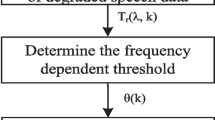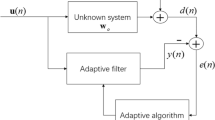Abstract
In the high-speed mobile wideband communication system, motions of receivers, transmitters or wireless environments generate Doppler frequency. The Doppler effect and instantaneous fading frequency induces serious waveform distortion in the received signal. To solve these problems, the paper presents an improved equalization model, the new model combines the Bayesian detector and decision feedback equalizer (DFE) to form a new effective BDFE structure, which is superior to traditional equalization structure in the mobile environment. Further, a new algorithm is given to achieve faster convergence and smaller steady-state error, the new algorithm take Marr function as a basis function, and two parameters shape the profile of function, with the simulation tool, the optimization values are obtained for the new model and algorithm. The experimental results show that the new algorithm can improve the output SNR up to 6 dB gain with the new BDFE model.
















Similar content being viewed by others
References
Jeong, S., & Moon, J. (2012). Easily computed lower bounds on the information rate of intersymbol interference channels. IEEE Transactions on Information Theory, 58(2), 864–877.
Xu, Z., Zhang, H., Hu, C., Mei, L., Xuan, J., Choo, K. R., et al. (2016). Building knowledge base of urban emergency events based on crowdsourcing of social media. Concurrency and Computation Practice and Experience, 28(15), 4038–4052.
Grokop, L. H., & David, N. C. (2009). Diversity–multiplexing tradeoff in ISI channels. IEEE Transactions on Information Theory, 55(1), 109–135.
Kubo, H., Murakami, K., & Fujino, T. (1994). An adaptive maximum-likelihood sequence estimator for fast time-varying intersymbol interference channels. IEEE Transactions on Communications, 42(234), 1872–1880.
Xu, Z., Zhang, H., Sugumaran, V., Choo, K. R., Mei, L., & Zhu, Y. (2016). Participatory sensing-based semantic and spatial analysis of urban emergency events using mobile social media. EURASIP Journal Wireless Communication and Networking, 2016, 44.
Zhang, G., & Dong, H. (2013). Underwater communications in time-varying sparse channels using passive-phase conjugation. Applied Acoustics, 74(3), 421–424.
Song, H. C., Hodgkiss, W. S., Kuperman, W. A., Stevenson, M., & Akal, T. (2006). Improvement of time-reversal communications using adaptive channel equalizers. IEEE Journal of Oceanic Engineering, 31(2), 487–496.
Rouseff, D., Jackson, D. R., Fox, W. L. J., Jones, C. D., Ritcey, J. A., & Dowling, D. R. (2001). Underwater acoustic communication by passive-phase conjugation: theory and experimental results. IEEE Journal of Oceanic Engineering, 26(4), 821–831.
Yang, T. C. (2004). Differences between passive-phase conjugation and decision-feedback equalizer for underwater acoustic communications. IEEE Journal of Oceanic Engineering, 29(2), 472–487.
Lasaulce, S., Sellami, N., Yuan, Y. & Saadani, A. (2003). Performance study of least-squares channel estimation based on hard decisions. In Proceedings of the Vehicular Technology Conference (vol. 4, pp. 2570–2574). Orlando, FL.
Reddy, B. S. K., & Lakshmi, B. (2015). Improvement in the performance of WiMAX with channel equalizers and space time block coding techniques using simulink. Wireless Personal Communications, 84(4), 2815–2833.
Dowling, D. R. (1994). Acoustic pulse compression using passive phase-conjugate processing. The Journal of the Acoustical Society of America, 95(3), 450–1458.
Adrián-Martínez, S., Al Samarai, I., Albert, A., et al. (2012). Measurement of atmospheric neutrino oscillations with the ANTARES neutrino telescope. Physics Letters B, 714(2), 224–230.
Yang, T. C. (2003). Temporal resolution of time-reversal and passive-phase conjugation for underwater acoustic communications. IEEE Journal of Oceanic Engineering, 28(2), 229–245.
Hursky, P., Porter, M. B., Rice, J. A., & V. K. McDonald, V. K. (2001) Passive phase-conjugate signaling using pulse-position modulation. In Proceeding of the MTS/IEEE OCEANS Conference (vol. 4, pp. 2244–2249). Honolulu, HI.
Al-Dhahir, N., & Cioffi, J. M. (1996). Block transmission over dispersive channels: Transmit filter optimization and realization, and MMSE-DFE receiver performance. IEEE Transactions on Information Theory, 42(1), 137–160.
Silva, F., Dinis, R., & Montezuma, P. (2015). Frequency-domain receiver design for transmission through multipath channels with strong doppler effects. Wireless Personal Communications, 83(2), 1213–1228.
Wang, J., & He, Q. P. (2007). A bayesian approach for disturbance detection and classification and its application to state estimation in run-to-run control. IEEE Transactions on Semiconductor Manufacturing, 20(2), 126–136.
Seddon, N., & Bearpark, T. (2003). Observation of the inverse Doppler effect. Science, 302(5650), 1537–1540.
Peres, A., & Terno, D. R. (2003). Relativistic Doppler effect in quantum communication. Journal of Modern Optics, 50(6–7), 1165–1173.
Zhou, W., Wu, J., & Fan, P. (2015). High mobility wireless communications with Doppler diversity: fundamental performance limits. IEEE Transactions on Wireless Communications, 14(12), 6981–6992.
Xue-Yuan, H., Xiao-Hong, Y., & Li-Xia, Q. (2015). The novel feed forward and decision feedback equalizer structures and improved variable step algorithm. Acta Physica Sinica, 64(23), 0238402. doi:10.7498/aps.64.238402.
Chen, H., Liu, Y., Jiang, W., et al. (2006). A new approach for synthesizing the range profile of moving targets via stepped-frequency waveforms. IEEE Geoscience and Remote Sensing Letters, 3(3), 406–409.
Chen, S., Hanzo, L., & Mulgrew, B. (2001). Decision-feedback equalization using multiple-hyperplane partitioning for detecting ISI-corrupted M-ary PAM signals. IEEE Transactions on Communications, 49(5), 760–764.
Smith, D. F., Donnelly, T., & Mapps, D. J. (1997). Fixed sample rate Bayesian detector in a variable speed magnetic channel. IEEE Transactions on Magnetics, 33(5), 2797–2799.
Chen, S., McLaughlin, S., Mulgrew, B., et al. (1995). Adaptive Bayesian decision feedback equalizer for dispersive mobile radio channels. IEEE Transactions on Communications, 43(5), 1937–1946.
Qi, Y., & Minka, T. P. (2007). Window-based expectation propagation for adaptive signal detection in flat-fading channels. IEEE Transactions on Communication, 6(1), 348–355.
Kwong, R. H., & Johnston, E. W. (1992). A variable step size LMS algorithm. IEEE Transactions on Signal Processing, 40(7), 1633–1642.
Li, T. T., Shi, M., & Yi, Q. M. (2011). An improved variable step-size LMS algorithm[C]//Wireless Communications, Networking and Mobile Computing (WiCOM). In 7th International Conference on IEEE (pp. 1–4).
Arablouei, R., & Dogancay, K. (2011). Modified RLS algorithm with enhanced tracking capability for MIMO channel estimation. Electronics Letters, 47(19), 1101–1103.
Sun, P., Zhang, C., Wang, Z., Manchon, C. N., & Fleury, B. H. (2015). Iterative ´ receiver design for ISI channels using combined belief- and expectationpropagation. IEEE Signal Processing Letters, 22(10), 1733–1737.
Badiu, M.-A., Kirkelund, G. E., Manchon, C. N., Riegler, E., & Fleury, B. H. (2012). Message-passing algorithms for channel estimation and decoding using approximate inference. In Proceedings of the IEEE International Symposium Information Theory (pp. 2376–2380).
Aboulnasr, T., & Mayyas, K. (1997). A robust variable step-size LMS-type algorithm: analysis and simulations. IEEE Transactions on Signal Processing, 45(3), 631–639.
Shin, H. C., Sayed, A. H., & Song, W. J. (2004). Variable step-size NLMS and affine projection algorithms. IEEE Signal Processing Letters, 11(2), 132–135.
Wang, W. Wang, Z., Zhang, C., et al. (2016). A BP-MF-EP based iterative receiver for joint phase noise estimation, equalization and decoding. arXiv preprint arXiv:1603.04163.
Gollamudi, S., Nagaraj, S., Kapoor, S., et al. (1998). Set-membership filtering and a set-membership normalized LMS algorithm with an adaptive step size. IEEE Signal Processing Letters, 5(5), 111–114.
Hwang, J. K., & Li, Y. P. (2009). Variable step-size LMS algorithm with a gradient-based weighted average. IEEE Signal Processing Letters, 12(16), 1043–1046.
Gollamudi, S., Nagaraj, S., Kapoor, S., et al. (1998). Set-membership filtering and a set-membership normalized LMS algorithm with an adaptive step size. IEEE Signal Processing Letters, 5(5), 111–114.
Hong, Y. S., Lee, H., & Tahk, M. J. (2003). Acceleration of the convergence speed of evolutionary algorithms using multi-layer neural networks. Engineering Optimization, 35(1), 91–102.
Low, S. H., & Lapsley, D. E. (1999). Optimization flow control—I: Basic algorithm and convergence. IEEE/ACM Transactions on Networking (TON), 7(6), 861–874.
Acknowledgements
This work was supported by the National Research Foundation of China grant funded by the China government (11374162) and University Natural Science Project (TJ215009), Nanjing University of Posts and Telecommunications research project (NY215162).
Author information
Authors and Affiliations
Corresponding author
Rights and permissions
About this article
Cite this article
Hao, XY., Yan, XH. & Zhao, J. A New Equalization Algorithms for Distortion Signal Extraction in Mobile Wireless System. Wireless Pers Commun 95, 1963–1980 (2017). https://doi.org/10.1007/s11277-016-3869-5
Published:
Issue Date:
DOI: https://doi.org/10.1007/s11277-016-3869-5




